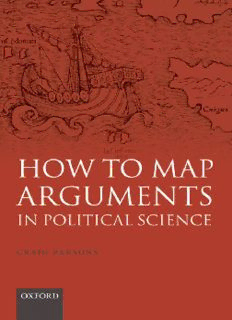
How to Map Arguments in Political Science PDF
Preview How to Map Arguments in Political Science
How to Map Arguments in Political Science This page intentionally left blank How to Map Arguments in Political Science Craig Parsons 1 3 GreatClarendonStreet,Oxfordox26DP OxfordUniversityPressisadepartmentoftheUniversityofOxford. ItfurtherstheUniversity’sobjectiveofexcellenceinresearch,scholarship, andeducationbypublishingworldwidein Oxford NewYork Auckland CapeTown DaresSalaam HongKong Karachi KualaLumpur Madrid Melbourne MexicoCity Nairobi NewDelhi Shanghai Taipei Toronto Withofficesin Argentina Austria Brazil Chile CzechRepublic France Greece Guatemala Hungary Italy Japan Poland Portugal Singapore SouthKorea Switzerland Thailand Turkey Ukraine Vietnam OxfordisaregisteredtrademarkofOxfordUniversityPress intheUKandincertainothercountries PublishedintheUnitedStates byOxfordUniversityPressInc.,NewYork ©CraigParsons2007 Themoralrightsoftheauthorshavebeenasserted DatabaserightOxfordUniversityPress(maker) Firstpublished2007 Allrightsreserved.Nopartofthispublicationmaybereproduced, storedinaretrievalsystem,ortransmitted,inanyformorbyanymeans, withoutthepriorpermissioninwritingofOxfordUniversityPress, orasexpresslypermittedbylaw,orundertermsagreedwiththeappropriate reprographicsrightsorganization.Enquiriesconcerningreproduction outsidethescopeoftheaboveshouldbesenttotheRightsDepartment, OxfordUniversityPress,attheaddressabove Youmustnotcirculatethisbookinanyotherbindingorcover andyoumustimposethesameconditiononanyacquirer BritishLibraryCataloguinginPublicationData Dataavailable LibraryofCongressCataloginginPublicationData Dataavailable TypesetbySPIPublisherServices,Pondicherry,India PrintedinGreatBritain onacid-freepaperby BiddlesLtd.,King’sLynn,Norfolk ISBN0-19-928667-1 978-0-19-928667-6 ISBN0-19-928668-X(Pbk) 978-0-19-928668-3(Pbk) 1 3 5 7 9 10 8 6 4 2 To mystudents Acknowledgements MydoctoralstudentsatSyracuseUniversityandtheUniversityofOregon provided the direct inspiration for this project. Their input and encour- agement led me to see that lecture notes from my field seminar in com- parativepoliticsmightbecomeabook—andthatunlikemostoftheother books I am likely to write, this one might address some fairly widely- perceived needs in our discipline. Later the students in my seminar in qualitativemethodshelpedmebroadenandsharpentheframework.I’m extremely grateful to all of them for pushing me to think aloud about theseissues. As the book came together I benefited enormously from comments frommanycolleagues,includingChrisAnsell,MarkBlyth,JimCaporaso, Peter Hall, Marc Morjé Howard, Nicolas Jabko, Peter Katzenstein, Rogan Kersh,NedLebow,JonMercer,RonaldMitchell,BrianRathbun,Alexander Wendt, and Daniel Ziblatt. The most critical comments (in both senses of ‘critical’) came from the same person who was most important in improving my first book, A Certain Idea of Europe: Andrew Moravcsik. Muchlikewiththatearliervolume,Andyprovidedawake-upcallonthis projectthatmadeitimmeasurablystrongerinthelaterevisions.Hemay still not find the results persuasive, but I must thank him once again for forcingmetobemorecareful,comprehensive,andclear. Icouldnothavefinishedthebookasquicklyoraswellwithoutgener- ousleavefromSyracuse,theresearchtimeaffordedbythequartersystem at Oregon, and the early faith of my OUP editor, Dominic Byatt. And I could do very little at all without the love and support of my wife Kari, andthejoythatTorandMargauxbringtomylife. CraigParsons Eugene,Oregon January2007 Contents PartI. Introduction Introduction 3 1. BoundariesandDivisionsinExplanationofAction 21 PartII. Logics 2. StructuralExplanation 49 3. InstitutionalExplanation 66 4. IdeationalExplanation 94 5. PsychologicalExplanation 133 Conclusion 163 References 174 Index 194 vii This page intentionally left blank Part I Introduction
Description: